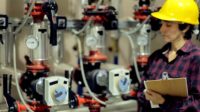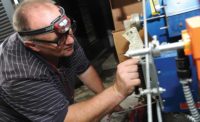The decarbonization of heating hot water (HHW) systems is an important and necessary step in the building industry’s effort to combat climate change. Existing heating hot water systems can be decarbonized by replacing existing fossil fuel-based heating systems with high-efficiency electric heat-pump-based heating systems in parallel with national and regional efforts to improve the source efficiency of the electric grid as a whole.
Replacing fossil fuel boilers with electric heat pumps is a significant technical challenge, particularly in cold climates. Perhaps the most critical consideration when designing a heat pump system is the lift the heat pump will be subject to. Heat pump lift is defined as the temperature difference between the heat source and the water temperature being produced. Minimizing lift to the greatest extent possible allows for significantly higher heat pump coefficients of performance (COPs), as shown in Figure 1, and in cold climates, increases the number of manufacturers and products available to meet the performance specification. The best option for minimizing lift in cold climates is to use a relatively high-temperature heat source, such as a ground heat exchange loop or wastewater source. In applications where outside air is the only available heat source, the only variable left in the designer’s control is the heating hot water supply temperature (HHWST) the heat pump is producing, which leads us to the focus of this article.

Understanding VAV Box Heating Coil Performance
Operating at low HHWSTs is a critical component in any heating hot water system’s decarbonization effort; however, the ability of existing heating hot water systems to operate at HHWSTs lower than they were originally designed for varies significantly. In the past, higher temperature (180°F+) HHW systems were common. Higher temperature water allows for smaller, higher efficiency heating coils throughout the system and can be generated at similar efficiencies to lower temperature HHW in traditional fossil fuel boilers and steam-to-hot water conversion applications. More recently, condensing boiler technology has increased the popularity of HHW systems designed for lower HHWSTs (120°-130°F) — low-temperature HHW return temperatures enable the boiler to condense moisture in the combustion air exhaust stream — increasing boiler efficiency from around 80% up to 95%. For heat pump-based heating hot water systems, the lower the HHWST the better; however, typical targets are approximately 110°-115°F.
Operating an existing HVAC system at a lower HHWST than it was originally designed for is a challenging task that may or may not be possible without significant renovation work of zone-level heating equipment. The remainder of this article will focus on the impacts of reduced HHWST on equipment capacity and delta T (dT) and discuss possible strategies for load reduction and equipment capacity increases.
Consider a hypothetical room in Chicago served by a single-duct shutoff variable air volume (VAV) with hydronic reheat with the following characteristics:
- Room size: 500 square foot with 12-foot, floor-to-floor height;
- Space heating set point: 70°F;
- 99.6% design outdoor air temperature: minus 1.7°F;
- Mass wall (90.1-07 minimum construction): U-0.090, north facing 175 square foot;
- Windows (90.1-07 minimum construction): U-0.55, 40% of wall;
- Roof (90.1-07 minimum construction): U-0.048, 175 square foot;
- Infiltration assumed: 35 cfm (0.2 cfm per square feet of exterior wall); and
- Room heating load: 8.1 kBtuh.
A typical VAV box sized for this load would have the following parameters:
- Box size: 8 inches;
- Total/heating airflow: 700 cfm/500 cfm;
- Design entering air temperature (EAT): 55°F;
- Design heating hot water supply temperature (HHWST): 180°F;
- Leaving hot water temperature: 135°F;
- Heating coil capacity: 9.5 kBtuh;
- Number of coil rows: two; and
- Flow rate: 0.8 gpm.
Figure 2 shows the heat delivered to the room by this standard VAV box with varying hot water supply temperatures at various flow rates, leaving all other factors unchanged (Note that in single-duct VAV reheat systems, the heating coil heating load will always exceed the heat delivered to the room because the heating coil load includes reheat). The room heating load is marked by a red horizontal line in the Figure. It becomes apparent that the supply temperature is the primary driver of heating capacity as opposed to flow rate. Beyond 2 gpm, the effect of increasing the flow rate on VAV performance is minor, and even this is dependent on HHWST — the curves have consistently lower slopes at lower HHWSTs. Thus, we cannot rely solely on increasing heating coil flow rates when implementing low-temperature hot water systems (there are also other considerations regarding high flow rates and existing systems, as discussed later in the article).

Figure 3 illustrates the VAV performance and hydronic dT at a constant hot water supply temperature of 110°F and flow rate of 2 gpm with various box sizes and number of coil rows. Heating coil surface area, which is a function of both the VAV box casing size/coil cross-sectional area and the number of rows is a significant determinant of heating capacity and hydronic dT — and is a vital consideration in low-temperature HHW systems. As low-temperature systems have become more popular, VAV box manufacturers have begun to produce three- to four-row units as standard and have also introduced non-traditional sizes, which incorporate smaller inlet sizes (to allow for low turndown) coupled with larger casing sizes. The terminology for these nonstandard sizes varies by manufacturer, but they are essentially constructed by putting an 8-inch inlet on a 10-inch casing, for example. When considering a low-temperature HHW system retrofit, the surface area of existing heating coils in the system is a substantial limiting factor that must be considered.

In most cases, a simple analysis will reveal that a reduction in HHWST will lead to a delta between design heating loads and existing terminal unit capacity. If the gap is relatively small, then load reduction and capacity increase strategies can be considered to help bridge the gap. Load reduction can be accomplished by improving the existing envelope performance, which is beyond the scope of this article, or by reconsidering the temperature conditions used to calculate design heating loads.
Design engineers typically base heating load calculations on design day data published by ASHRAE — based on a 99% or 99.6% design condition. The design day conditions do not represent the worst conditions the system may experience in a 10-year, five-year, or even one-year period. They are somewhat arbitrarily determined values to allow the HVAC systems to meet heating loads the majority — but not all — of the time. With the aim of decarbonization in mind, we may consider using slightly less stringent design day conditions to arrive at a feasible low-temperature hot water system. Figure 4 shows a demand curve of the heating load for the previously described baseline room in Chicago, calculated with outdoor air temperatures at every hour throughout the year. If a higher outdoor heating design temperature of 10°F (corresponding to an approximately 96% design condition) is selected, the room heating load is reduced by 19%.

Indoor temperature set points during the coldest days of the year may also be a variable a designer and owner may consider. Reducing the indoor temperature set point during peak winter conditions decreases the dT between the indoor and outdoor conditions, resulting in a reduced room heating load. It also increases the heating capacity of zone-level heating systems by increasing the dT between the supply air and room condition. Occupancy comfort is, of course, the primary consideration when evaluating the potential to reduce indoor temperature set points. Figure 5 depicts the estimated percentage of dissatisfied occupants at various indoor design conditions. The designer and owner can, together, determine whether a reduced indoor temperature set point during the coldest days of the year is acceptable for a particular application with consideration also given to freeze protection and building type. This approach may be acceptable for an office building but certainly wouldn’t be for a hospital. In the fight against climate change, asking occupants to wear a jacket or extra sweater on the coldest days of the year may be an approach worth considering for certain applications.

If these design temperature changes are applied to our example zone in Chicago, the effect is a load reduction of approximately 2 kBtuh. As is clearly depicted in Figure 6, the resultant load reduction is small relative to large reductions in HHWST. It should now be clear that increasing the hydronic flow rate to coils, and relaxing room and outdoor air design conditions, has a positive impact on system capacity, but the impact is minor relative to a large reduction in HHWST.

Another possible strategy to increase VAV box capacity is to raise the primary air supply temperature from the AHU/RTU via an existing or newly installed heating coil in the AHU/RTU. Figure 7 shows the heat the VAV box can deliver to the room at a 110°F HHWST for the previously described 8-inch box with EATs varying from 55°-70°F. The increase in capacity is significant; however, it comes with the risk of overheating interior zones. With typical winter clothing, zones could be overheated up to 78°F before more than 10% of occupants would be expected to be dissatisfied, using the assumptions stated in Figure 5. The risk and tolerance level for overheating interior zones during the coldest few days of the year must be considered for individual applications.

Figure 8 concludes the VAV box example in Chicago by incorporating all strategies described in this article.
- Baseline condition;
- Lower HHWST from 180°F to 110°F;
- Reduce room load by adjusting set point and design day condition (if applicable and allowable);
- Increase EAT from 55°F to 70°F;
- Increase the GPM;
- Take credit for initial oversizing of box (if applicable and allowable); or
- Replace the box to incorporate oversized heating coil and/or additional rows as required.

Other System Types
Different zone-level systems will have different considerations. For example, fan-powered terminal units (FPTUs) will respond similarly to VAV boxes; however, increasing the primary air supply temperature will have a much smaller impact since primary airflow is at a minimum during peak heating conditions. Perimeter fin-tube radiators (FTRs) respond very poorly to reduced HHWSTs.
Figure 9 illustrates the effect of lowering entering water temperature through a 10-foot active section of ¾-inch copper tube with 4-1/4-by-4-1/4-inch aluminum fins spaced at 40 fins per foot.

Depending on the original design HHWST and the desired HHWST, the decrease in output can be over 200%. If FTR happens to be the only source of heat for a space, chances are high that it will need to be replaced entirely or supplemented with another heat source.
Additional Considerations – Balancing and Controls
If increasing hot water flow to existing terminal units is under consideration, several factors must be analyzed. The first is the existing balancing method. The following are typical methods of balancing hydronic coils in the industry today.
- No balancing;
- Manual balancing valves;
- Automatic flow control valves; and
- Pressure-independent control valves.
In the case of no balancing, flow can be increased simply. For manual balancing valves, flow can be increased simply; however, the valves should be rebalanced (opened) to accommodate the new, desired flow rate (or replaced if necessary). Automatic flow control valves actively prevent flow from increasing beyond a specific flow rate regardless of the upstream hot water system pressure. To increase flow, the valves cartridge can be replaced, the valve itself can be upsized, or the valve can be removed and replaced with a different balancing method. Pressure-independent valves will have similar considerations to automatic flow control valves.
The control strategy in place at the terminal unit must also be considered. Simple, historic control sequences in which the hot water control valve is modulated directly in response to room temperature are well suited to changes in flow rate and hot water temperature. More complex, dual-maximum logic control sequences, which have been a requirement of ASHRAE 90.1 since an Addendum ck to the 2010 version, require additional consideration. As depicted in Figure 10, from 0%-50% of the heating loop, the terminal unit discharge air temperature is increased from the AHU leaving air temperature to a programmed heating mode leaving air temperature. From 50%-100% of the heating loop, the airflow is increased from its minimum set point to its heating maximum set point. However, if the terminal unit is operating with a lower HHWST than it was designed for, it’s possible the initially programmed heating mode leaving air temperature will not be possible to reach, regardless of the amount of hot water flow through the coil. Depending on how the sequence is programmed, this may lead to the heating loop being “stuck” at approximately 25%-50% output and prevent the increase in primary airflow that exists in the second half of the control loop from taking place. This issue can be solved by reducing the programmed heating mode leaving air temperature (LAT) to a temperature that is possible to achieve with the new HHWST and flow rate in order to unlock the full heating capacity of the terminal unit.

Finally, the maximum flow rate that can be accommodated by the existing piping system must be considered. In general, for a given heating coil and fixed airflow rate, entering air temperature, and hydronic flow rate, the hydronic dT will decrease as the HHWST decreases. In addition, as flow rate is increased, hydronic dT will decrease further. In some cases, this relationship can lead to a “low dT syndrome” (a common issue in CHW systems) in the heating hot water system. In extreme cases, this relationship could lead to portions of the hot water supply piping exceeding its rated pressure. It is vital to consider the impacts of increased flow rates, reduced dTs on the existing hot water distribution piping, and design of new centralized heating equipment.
Conclusion
The ability of an existing HVAC system to operate with a lower HHWST than it was originally designed for depends on a multitude of factors including original system design HHWST temperature, balancing methods, control strategy, pipe sizing, the amount of safety and oversizing incorporated into the existing system, and the owner’s tolerance for relaxed design heating set points and outside air conditions. These factors will vary for each building, as will the heating loads that the systems are required to meet.
Even if a theoretical or “stress test” analysis of the existing HHW system indicates that lower HHWSTs are feasible, no central plant retrofit should be completed without a prior ASHRAE Level 3 audit and retro-commissioning (ideally data-based). The task of accommodating lower HHWSTs is difficult enough without issues, such as clogged strainers and improperly tuned PID loops, getting in the way.
Finally, in any low-temperature HHW system retrofit, it is likely that a certain percentage of the terminal units will require replacement. Establishing a budget and managing owner expectations for this eventuality should be an early consideration.







